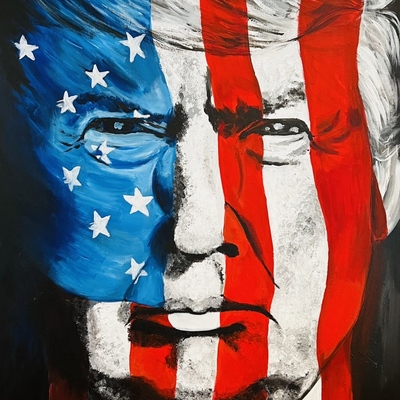Stay informed on the latest Truth Social posts from Donald Trump (@realDonaldTrump) without the doomscrolling. Consider it a public service for your mental health. (Why?)
- Tech Stocks, Industrial Stocks, and NASDAQ have reached all-time record highs.
- Cryptocurrency values are 'through the roof'.
- NVIDIA's stock is up 47% since the introduction of Trump tariffs.
- The USA is collecting hundreds of billions of dollars from tariffs.
- The country has fully recovered economically and is 'back'.
- The current economic strength is a 'great credit'.
- The Federal Reserve should rapidly lower interest rates to reflect the nation's economic strength.
- The USA should be considered at the 'top of the list' economically.
- There is no inflation.
The post directly mentions record highs in major stock indices (NASDAQ, implied S&P 500 via 'Tech Stocks, Industrial Stocks') and a specific, high-profile company (NVIDIA). Crucially, it issues a direct call for the Federal Reserve to 'rapidly lower rate' due to perceived strength and 'NO INFLATION!!!'. Such statements from a prominent figure can significantly influence market expectations regarding future monetary policy, potentially impacting equity valuations and the S&P 500's performance by shifting investor sentiment towards a more dovish Fed outlook.
The post focuses on domestic economic performance and monetary policy, containing no explicit threats, ultimatums, or military references that would suggest an escalation of international conflict.
- Commodities: Gold (XAU) might see price fluctuations based on the perception of the 'NO INFLATION!!!' claim and the call for lower rates, potentially influencing USD strength. Oil (WTI) could be supported by the asserted economic strength, indicating robust demand. Short-Term Watchlist: XAU/USD price action, oil inventory reports for demand signals. Medium-Term Focus: Inflation trends challenging or confirming the post's claim, Fed policy trajectory, global industrial output data.
- Currencies (Forex): The US Dollar Index (DXY) could experience downward pressure if market participants begin to anticipate rapid rate cuts from the Federal Reserve, making the dollar less attractive compared to other major currencies. Pairs like EURUSD might rise, and USDJPY could fall. Short-Term Watchlist: Fed official statements, US Treasury yield movements, shifts in global risk sentiment. Medium-Term Focus: Divergence in central bank monetary policies (e.g., Fed versus ECB/BoJ), global growth differentials influencing capital flows.
- Global Equities: S&P 500, Nasdaq, STOXX 600, Nikkei 225, and Hang Seng could receive a positive impetus from the prospect of lower US interest rates, which generally enhance equity valuations by decreasing borrowing costs and improving the present value of future earnings. The specific mention of NVIDIA highlights potential focus on technology and growth sectors. Short-Term Watchlist: Equity futures open, VIX levels (potential compression on dovish Fed outlook), performance of tech and semiconductor sectors. Medium-Term Focus: Corporate earnings revisions, macro economic indicators, global capital flows influenced by interest rate differentials.
- Fixed Income (Bonds): US 10Y and 2Y Treasury yields would likely decline if the market widely adopts the expectation of rapid Federal Reserve rate cuts, reflecting lower borrowing costs across the curve. This could represent a flight into duration as opposed to a safety-driven move, depending on the underlying reasons for rate cuts. Short-Term Watchlist: UST 10Y yield levels, market-implied probabilities of Fed rate cuts. Medium-Term Focus: Federal Reserve's dot plot projections, concerns surrounding fiscal policy and government debt, economic surprise indices.
- Volatility / Derivatives: The VIX (CBOE Volatility Index) might experience compression if the market perceives a clearer and more certain path towards lower interest rates and sustained economic growth, thereby reducing overall market uncertainty. Options positioning could adjust to favor strategies that benefit from lower volatility and higher equity prices. Short-Term Watchlist: VIX levels relative to its futures term structure, 0DTE (zero-day-to-expiration) options flow on major indices. Medium-Term Focus: Shifts in volatility regimes, the impact of macro policy certainty or uncertainty on implied volatility.
- Crypto / Digital Assets: Bitcoin (BTC) is highlighted as 'through the roof,' suggesting it is performing as a risk-on asset that benefits from liquidity and investor optimism. A potential environment of lower interest rates typically contributes to increased liquidity, which can positively influence cryptocurrency valuations. Short-Term Watchlist: BTC/USD price movements, correlation to technology stocks, cryptocurrency funding rates. Medium-Term Focus: Regulatory developments impacting digital assets, stablecoin flows, overall macro liquidity conditions.
- Cross-Asset Correlations and Systemic Risk: Current correlations between various asset classes might remain stable if lower rates are perceived as broadly beneficial. However, a rapid decline in bond yields alongside rising equity prices would exemplify the typical negative correlation. Systemic risk appears limited given the post's narrative of economic strength, but any sudden, unexpected policy shifts could introduce new market dynamics. Short-Term Watchlist: MOVE index for bond market volatility, co-movement between gold and the USD. Medium-Term Focus: Effectiveness of central bank communications, market responses to potentially conflicting economic data.
- Retail Sentiment / Market Psychology: The post's celebratory tone and specific mentions of 'CRYPTO, "Through the Roof."' and 'NVIDIA IS UP 47%' could significantly boost retail investor enthusiasm, potentially leading to increased speculative activity in growth stocks and digital assets. Short-Term Watchlist: Trading volume and price action in 'meme stocks' if applicable, social media trends and discussions on platforms like Twitter/X and Reddit. Medium-Term Focus: The broader influence of social media on market structure, the potential for coordinated retail-driven market movements, and any policy or regulatory responses to such behavior.

